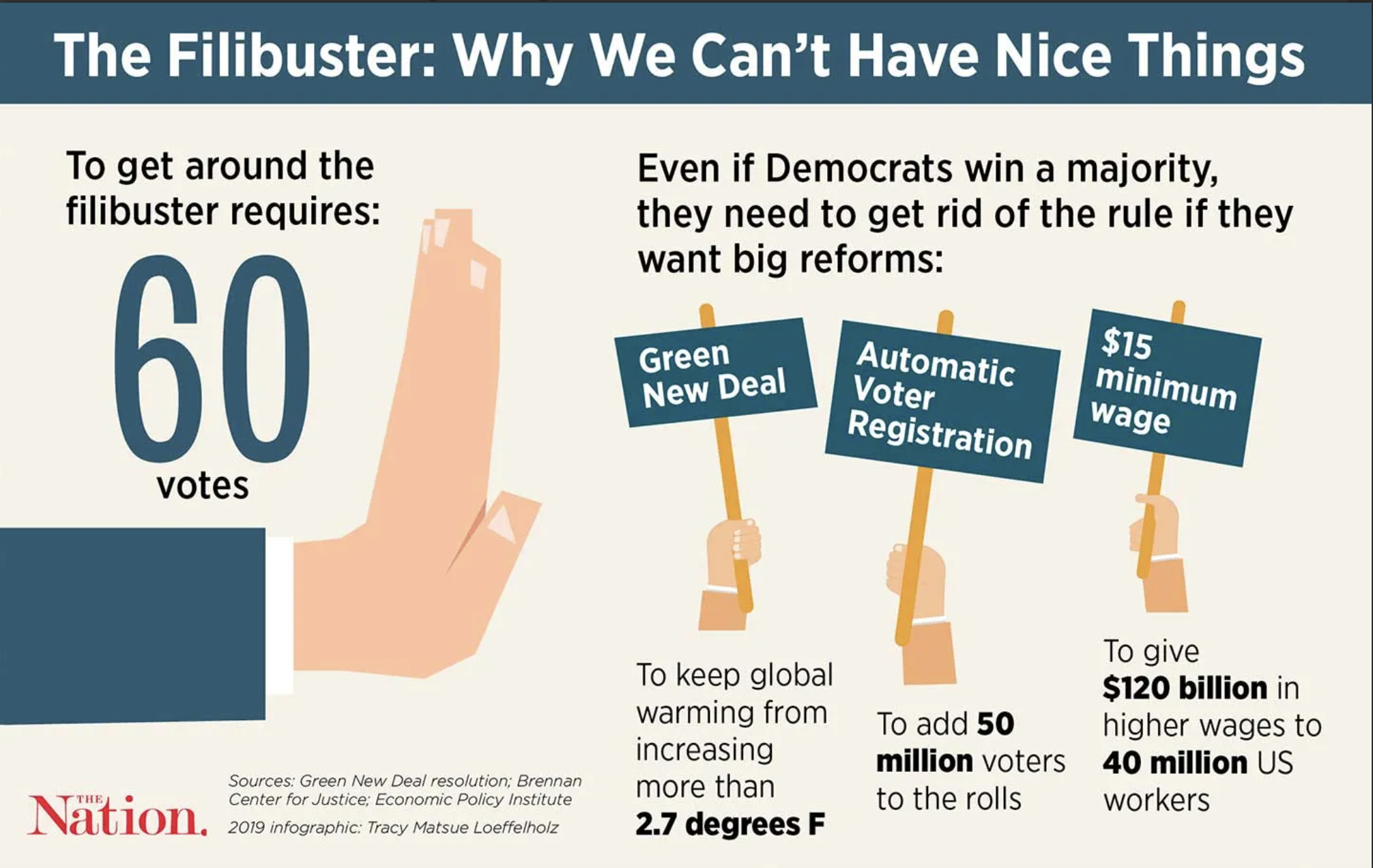The Fight Over The Filibuster
A brief explainer of the potential effects of the filibuster from The Nation’s Tracy Matsue Loeffelholz. Source.
This week, lawmakers in Washington sparred over the inclusion of the filibuster in the rules for the new Senate. In the United States Congress, a filibuster is the term used to describe when members of Congress use obstructive measures to delay or prevent a decision from being made on a piece of legislation. The US Senate defines a filibuster as an “informal term for any attempt to block or delay Senate action on a bill or other matter by debating it at length, by offering numerous procedural motions, or by any other delaying or obstructive actions.”
The filibuster has a long historical precedent in US politics. It became popular in the 1850s as a way to prevent a vote on bills in the Senate. Debate time was restricted in the House due to its large numbers but unlimited debate was allowed in the Senate because of its smaller numbers. In 1917, the Senate adopted a rule that allowed the Senate to end a filibuster with a two-thirds majority vote, also known as cloture. A two-thirds majority is rather hard to obtain, so even following this new rule, the filibuster remained an effective way to delay or prevent legislative votes. Filibusters were often used by southern senators to block civil rights legislation in the 1960s. In 1975, the Senate lowered the cloture threshold from two-thirds to three-fifths, making it somewhat easier to end a filibuster.
The filibuster is certainly an annoyance to the party in power because it allows the minority party to obstruct the majority’s agenda. As the filibuster rule currently stands, a minority of 41 out of 100 senators can prevent a vote on legislation. Abolishing the filibuster could allow Democrats in the Senate to more easily pass President Biden’s agenda — but there are also risks in doing so.
Many Democrats think Republicans have historically abused the filibuster to force their minority views on the entire country but, in recent years, the filibuster has been used by Democrats to block funding for Trump’s border wall, to protect unemployment benefits, and to stop Republicans from restricting abortion access. Abolishing the filibuster could allow Democrats to get things done while they are in power, but without a filibuster, the next time Republicans have the Senate majority Democrats will not have as immediate and effective a measure to prevent them from restricting voting access and eliminating reproductive rights.
Despite this complication, it may still be in the best interest of Democrats to abolish the filibuster. A study by the Center for American Progress found that Republicans have used the filibuster approximately twice as often as Democrats in preventing the other side from passing legislation. Senate Republicans led by Mitch McConnell have been notoriously obstructive and prevented Democrats from enacting policy even after the latter clearly win elections.
Regardless of party, the legal standing of the filibuster may need to be questioned. Filibusters are not mentioned in the constitution, but the line that states each house of Congress can write their own rules is used to justify the Senate’s use of the filibuster. The strategy also has a cloudy moral history. Historically, the filibuster was predominantly used to protect discriminatory Jim Crow laws.
In 2019, Massachusetts SenatorElizabeth Warren told the National Action Network that “for generations, the filibuster was used as a tool to block progress on racial justice. And in recent years, it’s been used by the far right as a tool to block progress on everything.” The country awaits to see whether this session of the Congress will be the one to attempt governance without it.

